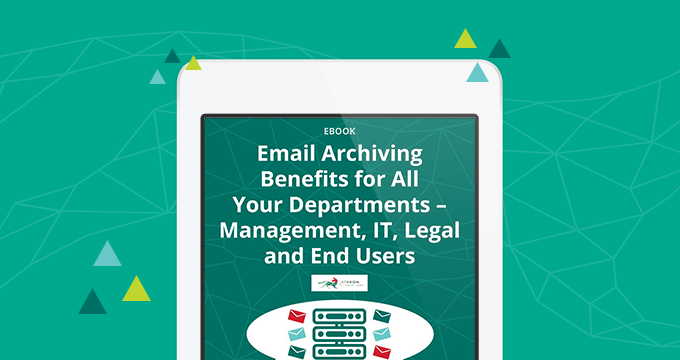Since its inception in 1971, email has come a long way (it practically eradicated snail mail to begin with). Today, email is the lifeblood of small businesses and enterprises alike – so much so that whole industries have been built around email storage management and email management software.
What is it about email that creates the need for email storage management? The answer is in its sheer volume.
In their most recent Email Statistics 2022-2026 report, The Radicati Group research team concluded that “email continues to be an essential part of daily business and consumer communication”.
Over a half of the world population uses it (4.2 billion in 2022). The total number of emails exchanged daily (both business and consumer) in 2020 is likely to exceed 333 billion, with the tendency to rise to over 392 billion in 2026.
Email vs. Chat Apps
Despite new channels like video, social media and chat apps, email is still the starting point for It’s also the only one a lot of us are forced to use.
Some people find email slow, archaic, and often inefficient. But despite this, it still provides the framework for most business communication. Despite the rise of social media and instant messaging platforms, 86% of professionals still name email as their favorite form of communication.
So yes, email is still alive and convenient, but why has it become so difficult to keep it under control? To answer this question, we first need to look at the main functions of email in business.
Despite the rise of social media and IM platforms, 86% of professionals still name email as their favorite form of communication. Share on XWhat Are the Main Functions of Email?
How come email is still so important and what do we use it for? Here are some major functions of email for businesses together with the reasons why email storage management is key for successful long-term business operation and corporate governance.
Discussing business decisions
A vast majority of senior staff members and C-level executives (82%) still consider email to be the primary communication channel. Most business decisions continue to be communicated through email, especially when it’s important to reach multiple recipients.
A major downside of email lies in its volume – messages accumulate fast.
Anyone who’s ever conducted an email conversation with more than one person knows how quickly the volume of email messages can multiply and how messy email threads can be. With so many emails saved in different folders by different users, there’s plenty of potential for chaos. That’s why having an email management strategy is crucial.
Sharing documents
Email remains the most popular method for document sharing within companies. Whether it’s a contract to sign, a monthly report or a valuable business document, you’ll most probably send it as an email attachment. A disadvantage is that attachments can be bulky, which quickly results in clogged email servers. To avoid overloading your systems, it’s mandatory to have some kind of email storage management strategy in place.
Evidence in court
These days, many business decisions are confirmed via email. This means email messages have become official documents in their own right.
Effective email storage management is vital in ensuring that these documents don’t get deleted or shared inadvertently and that they are held securely.
Moreover, internal and external auditors and regulators have the right to request your organization’s email history in case there’s a pending lawsuit or charges of fraud, embezzlement or employee misconduct.
In such cases, your litigation response needs to be quick. Without a proper email storage management strategy or a dedicated email archiving solution, companies are forced to extract data manually, which can take weeks and cost a lot — some Fortune 500 companies pay up to $30 million for ediscovery annually.
What Is the Definition of Email Storage Management?
Email storage management is a process in which organizations implement strategies, policies, best practices and tech solutions to control and manage high volumes of email and improve the performance of email servers.
Some of the common ways to manage email storage are:
- Email quotas
- Attachment limits
- Spam filters
- Stubbing
- Deduplication, single instance storage and compression features
- Email archiving
3 Ways to Improve Email Storage Management
Although it seems like we’re spending less and less time using email, managing emails is harder than it’s ever been. Simply typing “email management tips” in Google returns over 2 billion results. It’s so challenging that entire schools of thought have emerged around the concept of effective inbox management.
The most popular ones are the 1-hour rule, which says that you shouldn’t waste an average of 2.5 hours handling emails back and forth, but dedicate a one-hour slot to handle everything at once, once a day only.
Next in popularity is the notorious inbox zero — a “rigorous approach to email management aimed at keeping the inbox (almost) empty at all times”. Many have tried the 20/80 rule, whose main premise is that we should only focus on 20% of emails that bring maximum output.
There’s plenty of other advice out there, from getting a virtual assistant and unsubscribing from all the newsletters, notifications and alerts to strict categorization into folders and creating template replies.
In practice, email storage management is a business issue that most employees rarely see in action. The majority of us hit “send” and “delete” without being aware of the storage issues or possible repercussions. For your IT department, it’s not that simple.
With so much regulation around email retention, the email management process becomes all the more important.
Here are the top 3 email management functions and tips from Jatheon’s IT team:
1. Get your attachments right
The most common mistake in emailing is clicking “reply all” when you meant to click “reply”. This one is closely followed by the”‘please find attached” email with no attachment. This might just be a minor embarrassment for you, but it can create serious email storage management issues.
The follow up you’re forced to send creates extra email traffic and regulatory or ediscovery problems. Scanning an old tape for a particular email is a lot more difficult when important attachments are included.
2. Limit forwarding and pointless email threads
Don’t use email to forward memes or links to Twitter posts. Most staff hate being included in these mails, and they also clog up email storage management systems with spammy content.
Remember that the most important business emails are those that relay or generate key decisions.
Conversational or spammy internal mails add little value to your business and put undue pressure on your email servers.
A strict email usage policy should help to reduce the number of empty emails and help you keep a trim email storage management system.
3. Try to see the big picture
One of the popular ways to slim down your email load is to apply email quotas. A lot of businesses limit inbox size to ensure that employees retain important email and delete the rest. However, this can be a useful and sound tactic in theory, but it tends to be a little counter-productive in practice.
This is because this tactic has one major flaw — it’s prone to human error. By adopting it, organizations rely on an individual employee’s judgment to decide (usually when under pressure because their mailbox is full) which emails to keep and which to delete. This can result in a less useful email system on the whole and, in a worst-case scenario, leave you open to serious legal issues.
Effective email storage management means devising a comprehensive strategy which includes proper email retention policies and automated email archiving.
Email archiving solutions have multiple benefits — they make a copy of each email message that goes through your organization, which is then read against an index and archived on-premises, in the cloud or using a hybrid model.
This allows your employees to self-organize or even empty their inboxes, but still be able to search and find every single message, together with attachments and original metadata. The advantages of this approach are loved by other teams too, especially HR, compliance, legal, IT and email storage managers.
| To learn how you can improve your email management through email archiving, get in touch with us or book a demo. |
FAQ
What is email and its functions?
Email is an electronic communication method that allows individuals and businesses to exchange messages, documents, and other types of information over the internet. It is one of the most common and widely used forms of communication in personal and professional settings. It operates a client-server model, with users accessing their email accounts through email clients (software applications) that connect to email servers.
What is the function of email in business?
Email is the primary communication channel in business. It’s used both for internal and external communication to share information and documents, discuss ideas, and provide updates to colleagues, managers, and teams. A business email is a prerequisite for an employee to open accounts for multiple other business services. Email is also used by Sales and Marketing teams to send promotional and lead-generation campaigns.
What is email account management?
Email account management is the process of configuring, maintaining, and organizing an email account effectively. It involves account setup, security and authentication, email client configuration and server settings (IMAP, POP3, SMTP), archiving, sorting, filtering, backup and data loss prevention and other tasks.
What is email management?
Email management is the process of managing high volumes of emails received by organizations. It involves streamlining the email workflow, reducing clutter, improving productivity, archiving or deleting old and irrelevant email to prevent hitting storage quotas. Effective email management is crucial for organizations to stay in line with data protection and regulatory compliance laws that govern email retention.
What is email storage space?
Email storage space is the amount of digital storage allocated to store email messages, attachments, and other data in an email account. The amount of storage depends on the email service provider and whether it’s a free, paid, or business account.
Does archiving email reduce storage?
Yes, archiving removes old emails from your main inbox, freeing up space for new messages. It’s also useful because it improves email server performance because emails get moved to another location and the primary storage is less cluttered.








